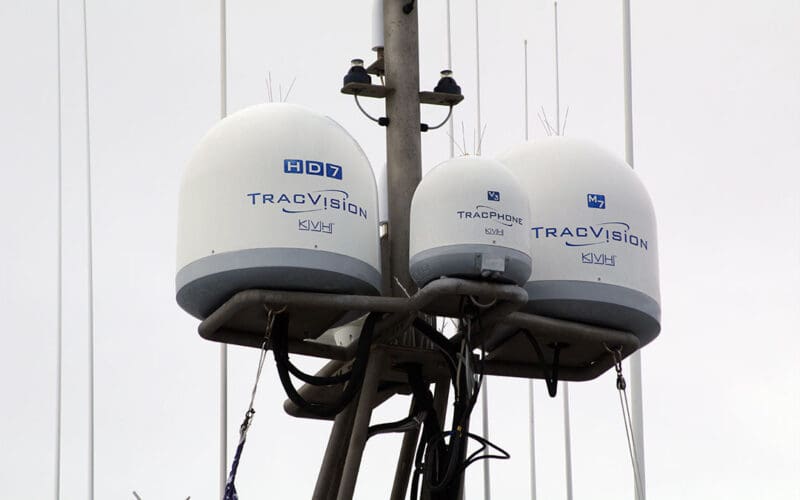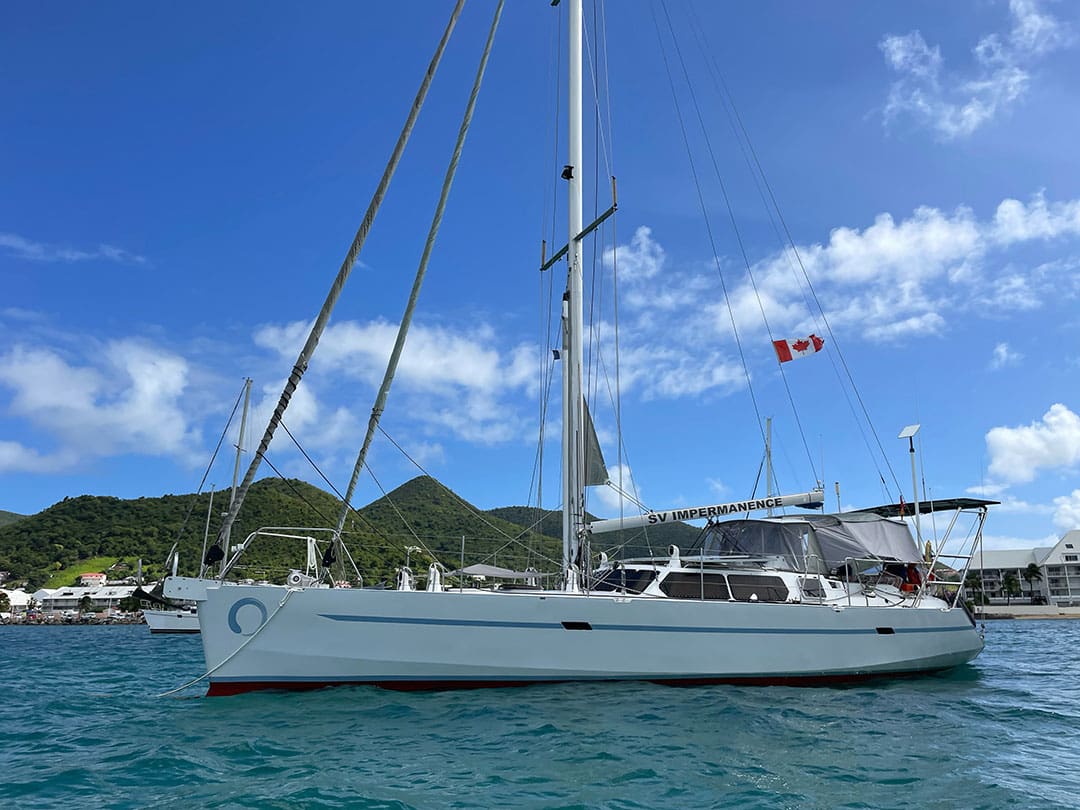 The race among satellite internet providers to enable fast, effective communications for ocean voyagers while underway or at anchor is heating up with worldwide coverage, faster download speeds and competitive prices.
The race among satellite internet providers to enable fast, effective communications for ocean voyagers while underway or at anchor is heating up with worldwide coverage, faster download speeds and competitive prices.
No longer are cruisers forced to depend on marine single side band, ham radio or the unassuming yet still necessary marine VHF radio to make contact with the world beyond their decks. A whole new generation of handheld satellite telephones and deck-mounted satellite antennas have opened up world communication for yacht owners who have the need and the funds to install these amenities aboard their vessels.
Until recently, the average offshore cruising boat’s access to satellite communications was relegated to text-only services (more on this below) or more expensive satellite phones (either via a handheld sat phone or a stabilized antenna in a dome).
The text-only services were those such as the DeLorme InReach, Iridium GO and SPOT Global Phone satellite devices, which are still popular on many ocean cruising vessels. Such systems also operate as hand-held cruising computers, offering such basic passage-making data as GPS position, weather conditions, ETA and texting with fellow voyagers and family back home.
To be sure, these basic handheld devices still deliver a great value for the budget-minded cruiser. If there is still one good reason for sticking to a DeLorme InReach or similar handheld communication device, it is definitely the price. Not only is the unit affordable at about $400, but you can get a user plan for around 15 bucks per month.
The inReach app enables you to view your location, plan navigation routes and manage waypoints on your iOS or Android device. So you save money by not having to purchase a second text-capable device.
Globalstar is aggressively pursuing its plan to enable users around the world to tap into its SPOT Global Phone system. The SPOT is a small, handheld Android device enabling text and voice communication from any point on the globe. As a small yet aggressive competitor in the low-orbit satellite internet industry, Globalstar has 48 low Earth orbit (LEO) satellites around the globe providing worldwide service.
Mesh network
Yet another player growing in influence within the global data sphere is Orchestra, offered by Inmarsat, which will be making its new “mesh network” of roughly 150 to 175 low-orbit satellites available to the world’s multifaceted transportation network within the near future. This network will bring together data from airport terminals, cruise ships, railway systems and truck fleets around the globe.
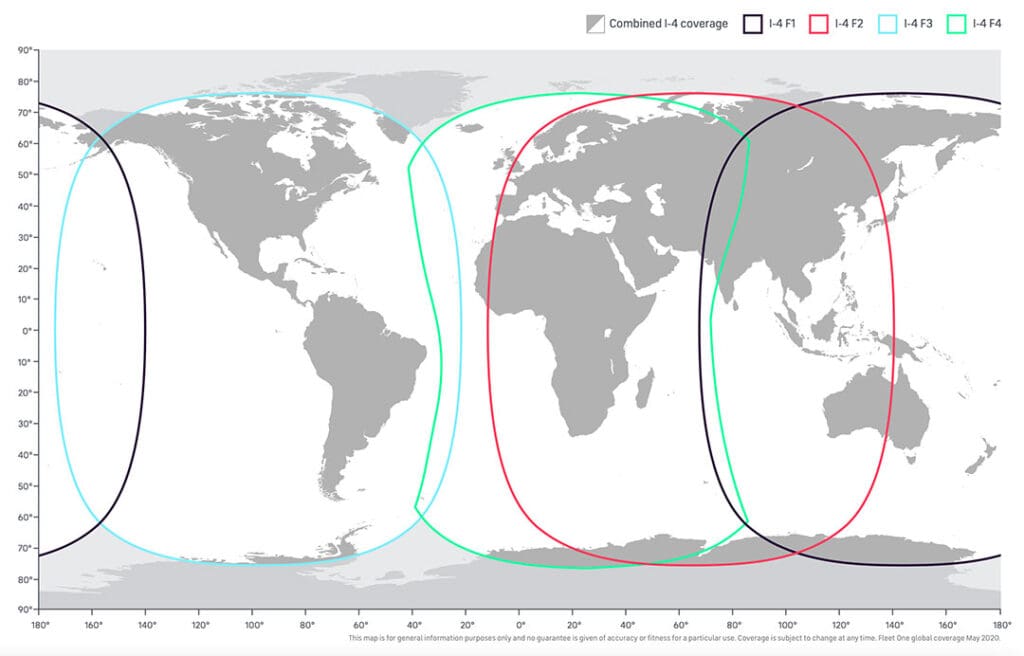
Orchestra’s cloud-based services connect every aspect of business, from product and service providers to local businesses and end-user customers. This sounds promising for big players in the professional transportation arena, but the company has said little if anything regarding devices or services for private individuals.
For offshore sailors, electronic data systems have been limited until recently to text and voice service without video. Obviously, these are still a great leap from the VHF and SSB radio. The small, handheld phones continue to ensure secure digital data sharing among their users. However, small, portable text and voice satellite communications are a still a long way from the fast video services we enjoy on land.
Now imagine being able to video chat with your loved one, or a business associate, on Zoom or Skype from anywhere on the globe. That means full, high-speed internet service from any point on land or sea. This is where the big players come in.
A new generation of internet providers is using low Earth orbit (LEO) satellites to receive and transmit digital signals to points around the globe at a much faster speed than higher-altitude geostationary satellites. GEO satellites hover over the planet at exactly 22,236 miles (35,786 kilometers), which, along with queuing and switching, adds a slightly longer delay in download speeds.
Satellites go low
The lower operating altitude of LEO satellites eliminates much of this slight delay, making data transmission and reception virtually instant. In an emergency where you are unable to make contact via VHF or SSB radio, having instant access to emergency services from the U.S. Coast Guard or, if beyond U.S. waters, from a comparable authority in your corner of the world’s oceans can mean the difference between life and death.
Fortunately for those of us in North American waters, we have a short but growing list of internet providers utilizing LEO satellite technology. Prices are still significantly higher than those of GEO satcom services but will still fit within the budget of many cruisers. And certainly, as the competition grows, we can expect current monthly service costs to drop before long.
Starlink, a leading competitor in satellite communications, now offers full internet service for both land-based and maritime access. Starlink, which bills itself as “the world’s largest satellite constellation,” uses a LEO array of satellites providing larger, faster downloads (up to 350 Mbps) than ever before.
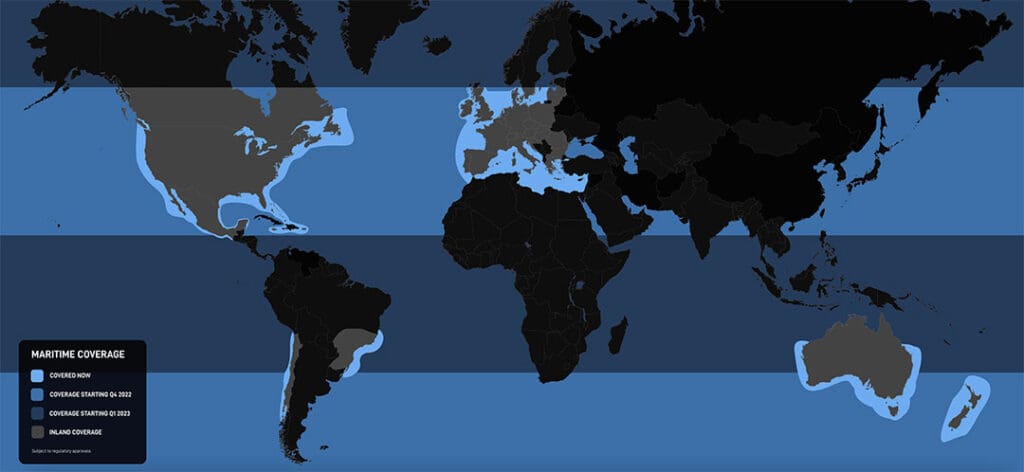
After ordering your equipment, you will need to engage the services of a monthly subscriber plan, such as that offered by Network Innovations, which provides communications solutions and services. Like other providers in this space, Network Innovations boasts a long list of services, starting with professional installation and technical support.
Network Innovations ensures the antenna you choose is mounted at a point on your vessel where power and interface cables can be routed to your vessel’s fuse or circuit breaker panel and computer system neatly and professionally. Besides customized network and routing services, the Network Innovations subscriber plan includes cyber security protection, which is critically important for individuals who operate businesses from their vessels, and certainly for governments choosing this system for communications aboard military and coastal law enforcement vessels.
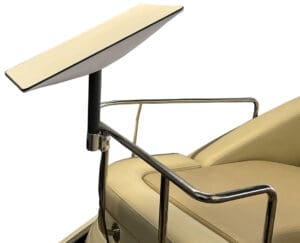
And when it comes to price, Starlink and Network Innovations together provide a highly competitive package: $110 per month with a one-time $599 cost for installation hardware. When I compared Starlink’s unlimited data plan to other companies, such as Viasat and HughesNet, which offer scaled data plans, it was really difficult for me to remain a dispassionate journalist on this subject — Starlink is clearly the superior choice.
Publisher Dave Abrams of Maritime Publishing (owner of Ocean Navigator) recently took the opportunity to test out his new Starlink system aboard his 58-foot Cape Horn trawler Lahaina Sailor on a cruise of Baja California, Mazatlan and Puerto Vallarta with a fleet of 24 other vessels on the Cruise Underway to Baja Rally (CUBAR). For aficionados of Pacific Coast yacht racing, this event was previously known as the Fleet Underway to Baja Rally (FUBAR).
As testament to the signal quality and coverage provided by Starlink, Abrams commented, “We had service the entire time, including when we were half-way across the Sea of Cortez, 100 miles from either coast.” He added, “Starlink worked well with only minor and temporary disruptions. Download speeds ranged from 140Mbps to 10 Mbps.”
Pointing to a detail truly favoring coastal sailors away from major metropolitan areas, Abrams added, “Higher speeds seem to be achieved in less populated areas.” In contrast to Abrams’ experiences at sea along a sparsely populated coastline, usually when we are on land, we associate better cell phone service with major population areas. Obviously, we send and receive more efficiently when we are close to cellular towers. Abrams’ enhanced reception was at least partially due to freedom from interference from those very same cell towers and associated phone traffic and lower numbers of users accessing each satellite when at sea.
Interestingly, Abrams was on the Starlink RV plan and therefore received occasional “out of area” notices after heading south from San Diego. However, his cell phone transmission and reception appeared to perform as well at sea as on land. Abrams added, “Bandwidth seemed tied more to population density than geography.”
Despite the superior performance of Starlink at sea, Abrams does share one caveat: “Starlink needs to see the northern sky. When anchored in coves with high hills on the northern part of an anchorage, performance was diminished significantly and at times unavailable.” Abrams’ observation is not limited to oceanic communication. He points out, “I found this same experience when traveling with Starlink in an RV.”
Many data products available
Abrams and other voyagers using Starlink attest to the service’s access to weather data, email, social media and video conferencing. Dave Brengelmann of Networks Innovations gives us a snapshot of where Starlink fits among competing internet providers in its class. “Starlink is the world’s first provider using LEO to deliver broadband internet.”
Network Innovations, which recently signed an authorized seller agreement with Starlink, offers its customers “premium support, annual hardware maintenance and complete installation services.” If Abrams’s experience is any indication, yacht owners should have little trouble accessing those services on their vessels.
To be sure, a few other systems do offer worldwide internet coverage, but they generally yield somewhat limited data speeds. KVH is a leader in marine internet services offering three grades of service through its KVH ONE “hybrid network.”
Each KVH installation is comprised of “integrated satellite, cellular and Wi-Fi technology,” including intelligent, automatic switching designed to keep the user connected around the clock.

If you walk over to that section of your marina where all the big boats are docked, you will see the familiar white Tracnet domes from KVH. These domes are available in three sizes: the TracNet H30, H60 and H90. The H90 features “a tuned carbon fiber dish” and includes integrated satellite, cellular, and Wi-Fi technology with intelligent, automatic switching. The H90’s data speeds can reach 20/3 Mbps (download/upload).
With the dome measuring a full meter in diameter and weighing 189 pounds, heavier than the typical crew member, this system is recommended for vessels measuring more than 90 feet on deck. At the humbler end of the scale, The TracNet offers data speeds of 6/2 Mbps and features a dome diameter of 14.6 inches and weight of 24.6 pounds.
Although KVH recommends this dome for vessels 30 feet or longer, I could not imagine myself bolting a 25-pound dome to a spreader on my 1966 Cal 30 sloop Saltaire. At 21 feet above the waterline, that comes to a potential 525 foot pounds of leverage in a strong wind, depending on the angle of heel.
In comparison, Starlink’s antenna system is comprised of a flat, lightweight panel that can be mounted to the cabin top or aft pulpit. The open-air design allows you to adjust the angle for best reception. Given the recent nature of Starlink’s use aboard voyaging vessels at sea, it remains to be seen how well its antennas, receivers and cabling will hold up to the rigorous marine environment over time — corrosion and the odd boarding wave can be challenging for electronic equipment. Older satcom systems that use stabilized dish antennas have enclosing domes that protect the gear inside.
Major price drop
If we look at pricing, Starlink started out in early 2022 charging an outlandish $10,000 for their antenna and receiver system, plus $5,000 per month for service. To say they have moderated pricing since then is an understatement: you can now purchase the Starlink system for $599 with a monthly fee of $110.
The KVH TracNet H30, on the other hand, will set you back $18,000 plus a monthly plan ranging from $164 to $2,317, depending on the amount and speed of data download/upload.
Again, if you own a very large yacht of 100 feet or more LOA, you may wish to invest in a large system like KVH, Viasat or HughesNet. The Sailor 900 Viasat Ka antenna dome contains a three-axis Ka-band antenna array, which serves a terminal designed for high-speed maritime broadband communications on the Viasat 2 and Eutelsa Ka-Sat networks.
The price for the Viasat Ka antenna dome and installation hardware is being offered by satellitephonestore.com for a little less than $50,000, and monthly plans range anywhere from $1,600 to $11,500 per month.
For yachts needing virtually flawless internet and voice communications capacity anywhere on the planet, probably nothing surpasses HughesNet, which as the company claims, literally invented satellite communications.
Hughes’ Jupiter system has deployed a worldwide array of terrestrial networks to close potential gaps in their satellite connections with Earth-bound users. This double-layer network design permits limitless roaming, whether you are sitting on top of Mount Everest or sailing through the Marquesas.
While the vessel is underway, passing from one satellite coverage area to the next, the HughesNet onboard terminal automatically switches from one satellite or Earth-bound terminal to the next.
For our tech heads out there, the Jupiter System Gateways and HT2500 router permit connectivity of up to 300 Mbps, which is almost as fast as Starlink. A large yacht naturally needs more detailed information regarding docking capacity in various ports, weather and security than, say, good ol’ Saltaire, who’s happy as a clam with her anchor set in the soft, white sand of some far-off island in the South Pacific.
There is obviously far more to learn about global satellite communications than we have covered here. And what’s more, new satellite hardware, software and monthly plans are popping up on the horizon all the time. But prudence suggests we as ocean voyagers can take a cue from guys like Dave Abrams by investing in a system that is fully responsive to our communication needs and also budget-wise. n
Circumnavigator-author Bill Morris believes the best strategy for succeeding as an offshore voyager is to keep systems simple and, if possible, manual. Morris is an Ocean Navigator contributing editor and the author of The Windvane Self-Steering Handbook (International Marine, 2004) and The Captain’s Guide to Alternative Energy Afloat (Seaworthy Publications, 2019).

